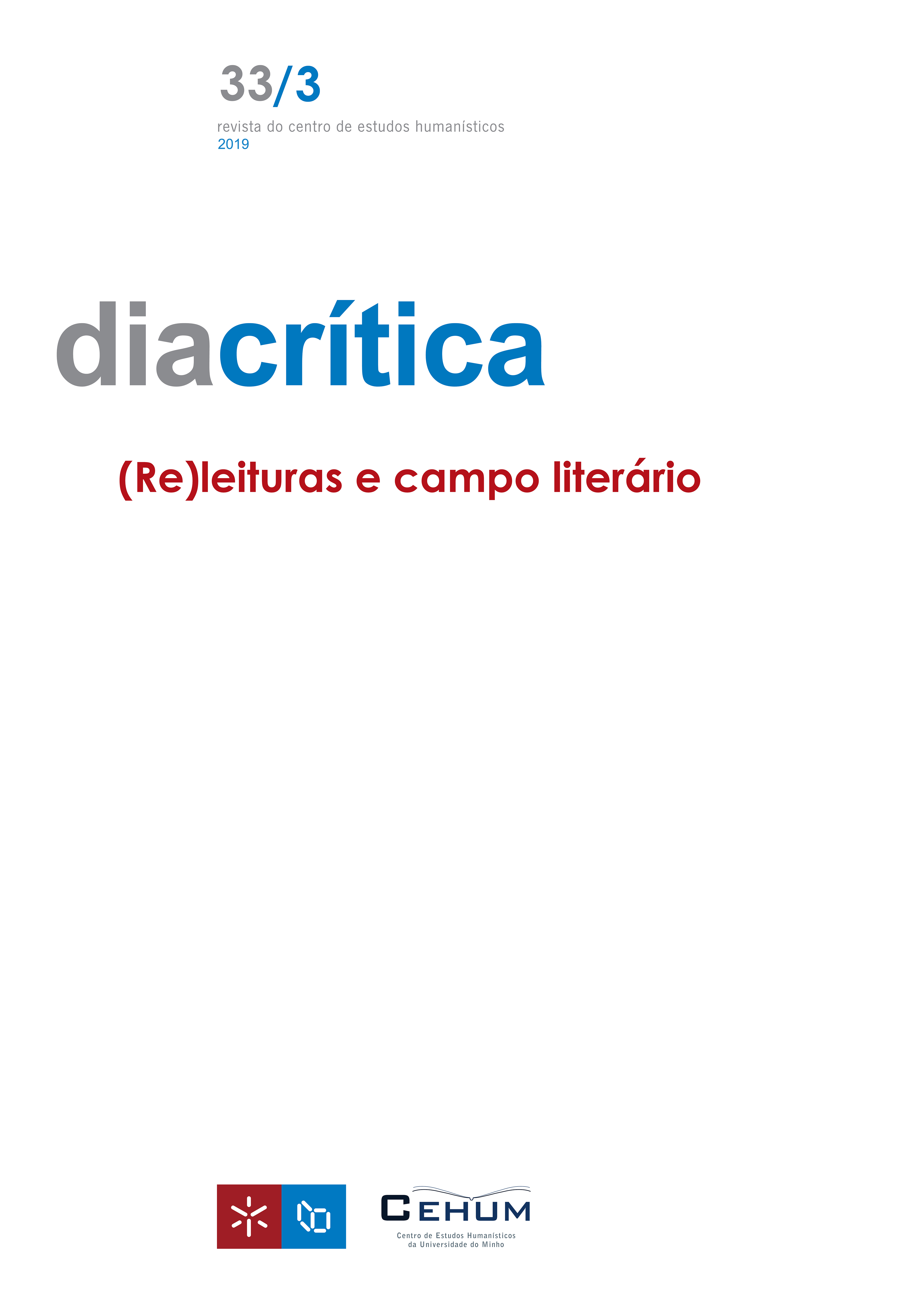As tornadas das canções nos séculos XII a XVI, dos trovadores a Camões
DOI:
https://doi.org/10.21814/diacritica.5075Palavras-chave:
Canção, História Literária, Estudos CamonianosResumo
Trata-se de um estudo da Canção (cansó, canzone, canción) como gênero num recorte histórico. À tarefa presta-se uma abordagem da retórica, como também da teoria e da história da comunicação escrita, e da história literária. Através da comparação de tornadas ou commiati em ordem cronológica, podemos ver como essa estrutura adquire progressivamente a função de estabilizar um teor moral conveniente ao modo compositivo, e como mais tarde essa orientação para uma ‘semântica textual’ é deslocada, com o enfraquecimento da valência moral, o que faz da tornada índice muito específico da pragmática histórica da escrita de poesia. Na segunda parte, o trabalho foca em tornadas de Luís de Camões, especialmente no modo como suas canções encenam esse deslocamento.
Referências
Alighieri, Dante(2014). Convivio. A cura di Giorgio Inglese. Milano: Rizzoli.
Alighieri, Dante (2011). De vulgari eloquentia. Sobre a eloquência em vernáculo. Tradução Tiago Tresoldi. Porto Alegre: Tiago Tresoldi.
Asperti, S.(2012; Org.). Bibliografia Elettronica dei Trovatori.BEdT v2.5 ed. Roma: Sapienza Università di Roma. Disponível em: <http://www.bedt.it/>.
Barreto, J. F. (1983). Micrologia Camoniana. Lisboa: Imprensa Nacional–Casa da Moeda.
Bembo, P.(2001a).Gli Asolani. Torino: Einaudi,.
Bembo, P.(2001b).Prose della volgar lingua. Torino: Einaudi.
Bembo, P.(2001c).Rime. Torino: Einaudi.
Boscán, J.(1999). Obras poéticas. Alicante: Biblioteca Virtual Miguel de Cervantes. Disponível em: <http://www.cervantesvirtual.com/nd/ark:/59851/bmcq8172>. Acesso em: 11 fev. 2019.
Brito, M.de (2019).A Teoria e a História da Literatura, e o Maneirismo. Alea, 21(2), 273–297 DOI: https://doi.org/10.1590/1517-106x/212273297
Burke, P.(2003). Uma história social do conhecimento: de Gutenberg a Diderot. Rio de Janeiro: Zahar.
Camões, L.de(2008). Obra completa. Rio de Janeiro: Nova Aguilar.
Canettieri, P. (s/d)Arnaut Daniel.Disponível em: <https://letteraturaeuropea.let.uniroma1.it/?q=laboratorio/arnaut-daniel>. Acesso em: 23 jan. 2019.
Canettieri, Paolo &Peretti, Alessio Marzialli. Guglielmo d’Aquitania. Disponível em: <https://letteraturaeuropea.let.uniroma1.it/?q=laboratorio/guglielmo-daquitania>. Acesso em: 23 jan. 2019.
Cascales, Francisco (1617).Tablas poéticas.Alicante: Biblioteca Virtual Miguel de Cervantes. Disponível em: <http://www.cervantesvirtual.com/obra/tablas-poeticas--2/>.
Chambers, F.M. (1985). An Introduction to Old Provençal Versification. Philadelphia: American Philosophical Society.
Chartier, R.(2014).A mão do autor e a mente do editor. São Paulo: UNESP.
Chartier, R.et al. (1996). Práticas de Leitura. São Paulo: Estação Liberdade.
Dios, Á. M.de (2011). Boscán, Juan. In: Aguiar e Silva, V. M. de (Org.). Dicionário de Luís de Camões (pp. 99–101) São Paulo: Leya.
Elias, Norbert(2001). A Sociedade de Corte. Tradução A.Telles. Rio de Janeiro: Zahar.
Erasmo de Roterdã (2013).Diálogo Ciceroniano. TraduçãoE. C.Sartorelli. São Paulo: UNESP.
Gaunt, S.(1989). Troubadours and Irony. Cambridge: Cambridge University Press. DOI: https://doi.org/10.1017/CBO9780511553912
Jeanroy, A.(1923). Jongleurs et Troubadours Gascons des XIIe et XIIIe Siècles. Paris: Champion.
Keen, C.(2014). Ovid’s Exile and Medieval Italian Literature: The Lyric Tradition. In: Miller, J.F. & Newlands, C.(Org.). A Handbook to the Reception of Ovid(pp. 144–160) Malden & Oxford:Wiley Blackwell. DOI: https://doi.org/10.1002/9781118876169.ch10
Lourenço, M.de S. et al. (2014). Os Lusíadas de Luís de Camões, com. por D. Marcos de S. Lourenço. Coimbra: Centro Interuniversitário de Estudos Camonianos.
Melanchton, P. & Wels, V.(2011).Elementa rhetorices Grundbegriffe der Rhetorik. Potsdam: Institutional Repository of the Potsdam University. Disponível em: <http://opus.kobv.de/ubp/volltexte/2011/5144/>.
Moos, P.von (2006).Rhetorik, Kommunikation und Medialität: Gesammelte Studien zum Mittel-alter, vol.II.Berlin: Lit Verlag.
Müller, W. G. (1994). Brief. In: Ueding, G.(Org.). Historisches Wörterbuch der Rhetorik. Band 2: Bie-Eul.(pp. 60–75) Tübingen: Max Niemeyer.
Peirano, I.(2014). “Sealing” the book: the sphragis as paratext. In: Jansen, L.(Org.). The Roman Paratext(pp. 224–242) Cambridge & New York: Cambridge University Press. DOI: https://doi.org/10.1017/CBO9781139168786.012
Pereira, B.Fernandes(2012). Retórica e eloquência em Portugal na época do Renascimento.Lisboa: Imprensa Nacional–Casa da Moeda.
Pereira, J. C.Seabra(2011). Augustinianismo em Camões. In: Aguiar e Silva, V.M.de (Org.). Dicionário de Luís de Camões(pp. 45–52) São Paulo: Leya..
Petrarca, F.(2001). Canzoniere. Torino: Einaudi.
Sannazaro, J. (1961). Rime disperse [Opere volgaridi Iacopo Sannazzaro] A cura di Alfredo Mauro. Bari:Gius. Laterza e Figli.
Sannazaro, J. (2007). Sonetti e canzoni.I Edizione IntraText CT. Eulogos. Disponível em <http://www.intratext.com/IXT/ITA1752/> Acesso em: 11 fev. 2019.
Visalli, S.M.(s/d).Marcabru.Disponível em: <https://letteraturaeuropea.let.uniroma1.it/?q=laboratorio/marcabru>. Acesso em: 23 jan. 2019.
Zumthor, P.(1993).A Letra e a Voz. A “literatura” medieval. São Paulo: Companhia das Letras.
Downloads
Publicado
Como Citar
Edição
Secção
Licença
Direitos de Autor (c) 2023 Matheus de Brito

Este trabalho encontra-se publicado com a Creative Commons Atribuição-NãoComercial 4.0.










